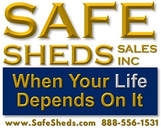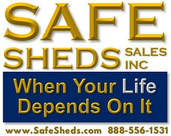|
When you're comparing above ground storm shelters, it's important to take a close look at what the floor of the shelter will be and how the shelter will be anchored in place.
In many above ground storm shelters, particularly in-garage steel units, there is no floor in the storm shelter you purchase. In other steel shelters, the floor is a piece of steel plate. In either case, the shelter ABSOLUTELY MUST set on a specific surface to ensure the user's safety. A storm shelter with no floor, or just a piece of steel for a floor, has be to installed on a steel reinforced concrete slab. And, if you're putting your shelter on an existing concrete slab, like a garage floor, if you don't have rebar reinforcing in the floor, you'll have to tear it out and pour a new slab. Failing to use the correct reinforced concrete floor renders the storm shelter unsafe and dangerous. Bolts driven into non-reinforced concrete won't provide enough strength to keep the shelter from coming up off of, or sliding across, the garage floor if it's struck by debris. A Safe Shed above ground tornado shelter, in comparison, has a 6" thick, steel rebar reinforced floor that is a seamless part of the entire shelter. The steel reinforcement in the floor and the walls are fastened together before concrete is poured to ensure that the walls and the floor cannot be separated if they are struck. And, because the shelter has a floor, there's no need to pour additional reinforced concrete pads on which to set the shelter. It can be set directly on the ground or a thin gravel pad. After a Safe Shed storm shelter is installed, it is anchored at all four corners to ensure it won't slide if it's struck by heavy debris. If the shelter is installed directly on the ground or on a gravel pad, the installer will use an auger to dig a 4' deep hole at each corner. A steel anchor is attached to the shelter and dropped into the 4' hole, then backfilled with additional cement. This creates the strongest anchor system available for above ground storm shelters on the market today. Weak anchoring endangers the lives of everyone who uses an improperly anchored storm shelter. Pay careful attention to requirements for anchoring and installation, and never cut corners. You can buy an "install-it-yourself" storm shelter and bolt it down to the floor of your garage with minimal effort. But if you don't install it correctly, or you place it on non-reinforced concrete, the shelter may very well prove to be useless when you need it most.
Jamie Golden
5/26/2016 06:52:30 am
Please let me know the styles, sizes and prices of your shelters. Also, how long will it take to install after the order is complete? Great article! I always tell our customers that is always better to be safe than sorry especially when you are talking about shelter. We own a metal building business and always stress to certain customers the importance of certain certifications that we offer to make the building/carport more secure. Great post. Thanks! Comments are closed.
|
AuthorMembers of the Safe Sheds team contribute posts from time-to-time. Archives
November 2017
Categories |
We always welcome your visit
1003 South Maple Street
Salem, Illinois 62881 Monday - Friday, 8:00 a.m. - 4:30 p.m. CST 888-556-1531 (toll free) 618-740-0044 (local) [email protected] |
Contact UsSubscribe |

 RSS Feed
RSS Feed
